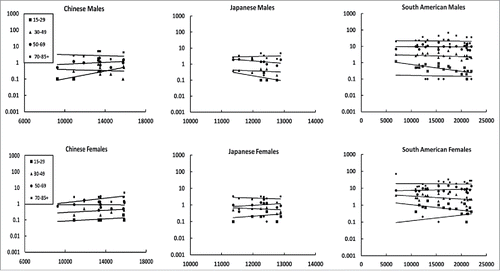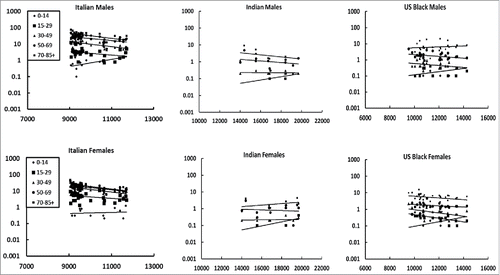Figures & data
Table 1. P values from the linear correlation of CMM with UVB dose for males and females in the 5 age groups in countries with different Fitzpatrick skin types I-VI. We consider p values < 0.05 to be significant. Values in bold show significant correlations between increasing UVB dose and increasing CMM, but those that are bold italicized have significant correlations between decreasing UVB dose and increasing CMM incidence. ND = no data above zero to analyze.
Figure 1. Age-standardized CMM cases per 100,000 people by personal UVB dose in J/m2 for males and females with Fitzpatrick skin type I-III. Semi-log plots were chosen for visual presentation only.

Figure 2. Age-standardized CMM cases per 100,000 people by personal UVB dose in J/m2 for males and females with Fitzpatrick skin type III-IV. Semi-log plots were chosen for visual presentation only.

Figure 3. Age-standardized CMM cases per 100,000 people by personal UVB dose in J/m2 for males and females with Fitzpatrick skin type IV-VI. Semi-log plots were chosen for visual presentation only.

Figure 4. The consequences of DNA photoproduct damage from exposure to outdoor UVA and UVB radiation versus indoor UVA radiation. Outdoor sunshine has both UVA and UVB radiation vs. indoor sunshine that has only UVA radiation because, unlike UVB, it can pass through window glass. The outdoor UVB radiation causes efficient pyrimidine dimer formation and UVA makes benzothiazine or benzothiazinylalanine and other radicals (λmax >340 nm) that cannot react with the pyrimidine dimers formed outdoors because the covalent bonds block the available reaction sites (competitive reaction); whereas, indoor UVA forms few dimers so that many pyrimidine sites are available to react with the benzothiazine radicals it forms. Besides UVA creating ROS that oxidizes deoxyguanosine to 8-oxodG (G = O in diagram), UVA can create ONOO- radicals that can also make CPD in the dark for several hours post exposure [80].
![Figure 4. The consequences of DNA photoproduct damage from exposure to outdoor UVA and UVB radiation versus indoor UVA radiation. Outdoor sunshine has both UVA and UVB radiation vs. indoor sunshine that has only UVA radiation because, unlike UVB, it can pass through window glass. The outdoor UVB radiation causes efficient pyrimidine dimer formation and UVA makes benzothiazine or benzothiazinylalanine and other radicals (λmax >340 nm) that cannot react with the pyrimidine dimers formed outdoors because the covalent bonds block the available reaction sites (competitive reaction); whereas, indoor UVA forms few dimers so that many pyrimidine sites are available to react with the benzothiazine radicals it forms. Besides UVA creating ROS that oxidizes deoxyguanosine to 8-oxodG (G = O in diagram), UVA can create ONOO- radicals that can also make CPD in the dark for several hours post exposure [80].](/cms/asset/af55efe2-0b41-49f4-9eee-ba2ebf338b2b/kder_a_1267077_f0004_b.gif)
